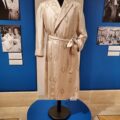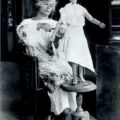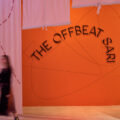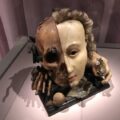1920s Jazz Age – Fashion and Photographs
November 19, 2016The cheerful sound of jazz fills the air, and a lady wearing a silver dress and immense feathers in her hair, elegantly perched high above us on a giant moon seems to be languorously enjoying it. Or perhaps she’s taking in the black and white projection of the Black Bottom and other jazz age dances being vigorously performed and getting some tips. But wait before you order a cocktail or two and get set to join in, this is not a nightclub but the Fashion and Textile Museum’s latest exhibition, 1920s Jazz Age – Fashion and Photographs.
1920s Jazz Age fashion and Photographs at the Fashion and Textile Museum – Review
The curator, Dennis Nothdruft, as you can perhaps guess, have gone to great lengths to bring the era alive though outfits, music, photographs, videos, displays and information which feels fresh and not quaint or dusty, though this era actually happened nearly a century ago. Amazingly, a lot of the beading and sequins that the Twenties is famous for retain their sparkle and the garments themselves are perfectly restored to give a real flavour of how it might have felt to pass them in the street or a club. Some jazz age exhibits are behind glass but not the majority, and the way that little groups of mannequins are arranged in front of a painted backdrop as if out for a picnic or a night of dancing is charming.
Evocative Tableau
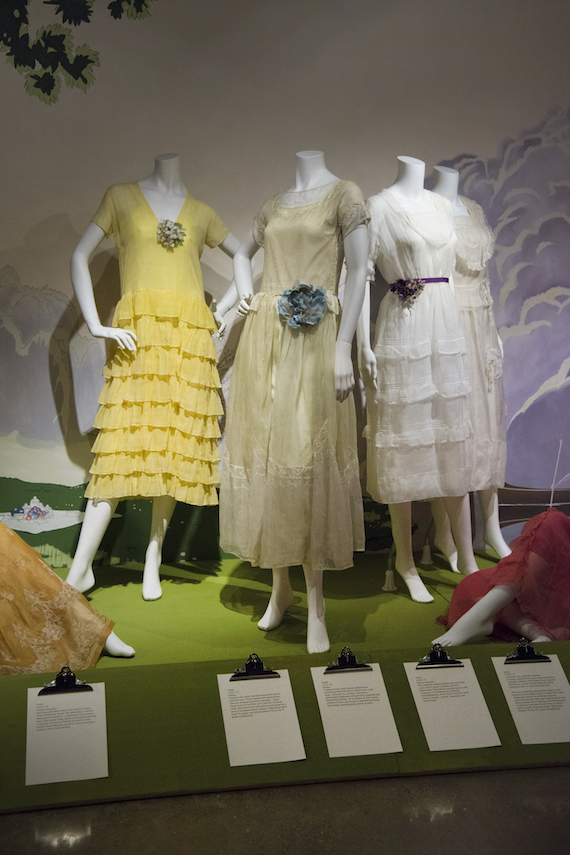
A scene from the exhibition.
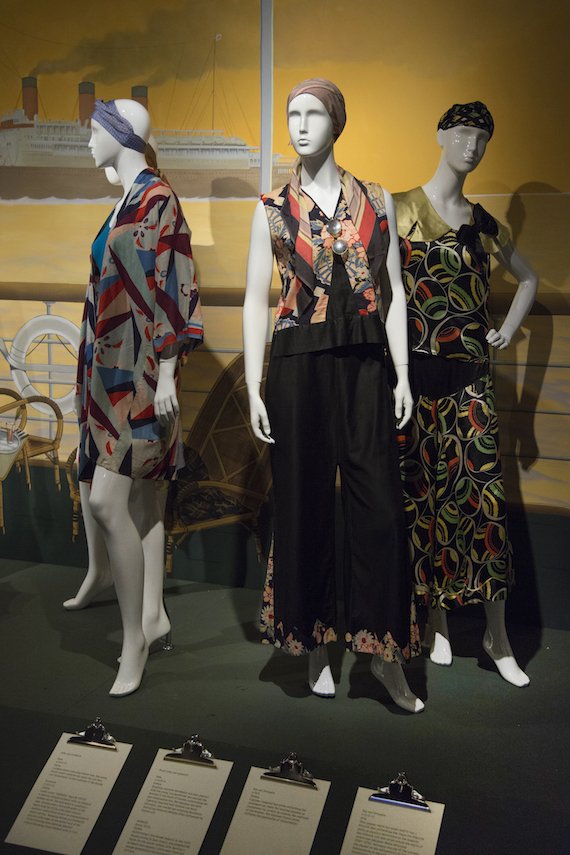
A scene from the exhibition.
1920s jazz age Tableau’s consist of ladies waiting outside for their rides, each resplendent in a silk velvet evening cloak and outré hat, shimmering in burnt orange, turquoise, gold, black and pink; a little boudoir scene with silk pyjamas and filmy negligees; a nightclub scene ablaze with beading, showing the boxy tubular shape that was the main silhouette at the time, a simple surface that lent itself extremely well to the surface decoration that was heaped upon it but also, more unusually, a silver lame dress with flaring knee length pleated skirt and nipped in waist, actually a lot like a classic 1950s dress.
Another example of the more unusual silhouette is a (presumable) copy of Jeanne Lanvin’s Robe de Style, a romantic idea that she borrowed from the 18th century and update to 1920s jazz age tastes. It featured a loosely fitted bodice to the natural waist, and then, much like those 18th century ladies of court fashion, panniers on the hips but not the bottom for a very wide but flat silhouette. Unlike the 18th century version which went to the ground, Lanvin’s stopped at the knee. Just as I was admiring it and thinking how romantic the effect was, and rare to see in real life, a loud voice from a visitor interrupted my mental rhapsodies. “Look at that one with the funny bum pads!” she pointed out in a broad Mancunian accent. Well, fashion always has been misunderstood.
The other Jazz Age scenes feature variously sporting ladies in swimsuits and very early tennis gear, the aforementioned picnic scene with beautiful pastel sundresses and another with light embroidered cotton voiles, the influence of Japanese kimono styles and early man made fabrics, and more.
1920s Jazz Age – The quintessential garçonne
Two matching, neatly put together vitrines feature young ladies getting ready for the evening, one femme, one garçonne. The garçonne, or boy-girl was a popular 1920s jazz age style, where a woman took on some masculine stylings such as trousers and short hair, but accented it with feminine lipstick and (for example) satin shoes. This garconne, lounging at her dressing table wears a chic monochrome outfit of crisp white shirt and black trousers, waistcoat, bow tie and top hat – the top hat decorated with a diamante buckle and on her feet delicate but streamlined black kitten heels. She has a cigarette in a long black holder and around her are strewn tortoiseshell ashtrays, art deco playing cards, hip flasks and a knocked over arsenic green wine glass, along with a powder compact.
The femme, sitting in her vitrine on the other side is attired only in her negligee and sleeping cap, rolling her stockings on. Her palette is pink and around her are ranged intriguing beauty tools: “The Tweaker” is a kind of enlarged pair of tweezers, meant for leg hairs, and there is a tiny “ladies boudoir safety razor” in case you miss a few. For the hair on the head there is a “shingle clipper”, and an “electric flapper curling iron”, as well as the “Lovelee hair net – bobbed size”, which boasts that it is handmade with real human hair. For those struggling with the ideal pout, a lipstick stencil is on hand. It’s all not unlike what you’d find if you popped into Boots today.
1920s Jazz Age stars
Although the models are blank faced, a gallery of portraits is displayed on one wall to give an idea of the look of the ideal woman of the times and her hair and makeup. They are all-stars, some still household names such as Clara Bow, Anna May Wong and Greta Garbo, others less well-known. Each has their own tiny line of bio to whet the appetite.
The Fashion and Textile Museum is not a big museum, although the Jazz Age exhibits are arranged over two floors, but the result is just about perfect; enough frocks that many aspects of life are demonstrated but without becoming repetitive or over-detailed. However, these clothes which have come from the collection of Cleo and Mark Butterfield who originally snapped them up on market stalls in the 1970s are centred around decorative and pretty leisure clothes for those who could afford them – not necessarily couture clients (I didn’t see any pieces named as being made by the great couturiers of the age) but the only maid’s outfit was to offset the grand dresses.
There was no display of plain and serviceable woollen dresses or factory worker’s uniforms, warm cardigans or thick stockings. in the 1920s Jazz Age exhibition. I imagine that is because that’s not what the Butterfields had their eye on, back when they were riffling through piles of second-hand clothes. The aim was probably not to create a complete social document but to preserve those delicate, often hand-made, pieces of embroidery and beading.
Informative and entertaining
The accompanying information is well researched and entertaining as well as informative. There are a lot of F Scott Fitzgerald quotes and I particularly enjoyed a panel that went with the sportswear section. Apparently in 1926, Lois Long writing for the New Yorker stated that “the best reason to play tennis this summer is the short, white wool socks, with a plain or striped cuff, worn over your lisle stockings and curled lovingly over the top of your tennis shoes.” I love how they used to write fashion columns.
1920s Jazz Age – Fashion and Photographs is at the Fashion and Textile Museum in Bermondsey until 15th January 2017.






